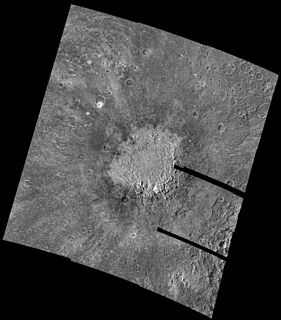
An impact crater is an approximately circular depression in the surface of a planet, moon, or other solid body in the Solar System or elsewhere, formed by the hypervelocity impact of a smaller body. In contrast to volcanic craters, which result from explosion or internal collapse, impact craters typically have raised rims and floors that are lower in elevation than the surrounding terrain. Impact craters range from small, simple, bowl-shaped depressions to large, complex, multi-ringed impact basins. Meteor Crater is a well-known example of a small impact crater on Earth.

The Galilean moons are the four largest moons of Jupiter—Io, Europa, Ganymede, and Callisto. They were first seen by Galileo Galilei in December 1609 or January 1610, and recognized by him as satellites of Jupiter in March 1610. They were the first objects found to orbit another planet.

Ganymede, a satellite of Jupiter, is the largest and most massive of the Solar System's moons. The ninth largest object in the Solar System, it is the largest without a substantial atmosphere. It has a diameter of 5,268 km (3,273 mi) and is 8% larger than the planet Mercury, although only 45% as massive. Possessing a metallic core, it has the lowest moment of inertia factor of any solid body in the Solar System and is the only moon known to have a magnetic field. Outward from Jupiter, it is the seventh satellite and the third of the Galilean moons, the first group of objects discovered orbiting another planet. Ganymede orbits Jupiter in roughly seven days and is in a 1:2:4 orbital resonance with the moons Europa and Io, respectively.
Dag, DaG, DAG, or dags may refer to:

Tindr is a crater on Jupiter's moon Callisto. It is named after one of the ancestors of Ottar in Norse mythology. This is an example of a central pit impact crater.

Asgard is the second largest multi-ring structure on Jupiter's moon Callisto, measuring 1600 km in diameter. It is named after Asgard, the realm of the gods in Norse mythology. The central part of Asgard is dominated by the domed Doh impact crater.

Located on Jupiter's moon Callisto, Valhalla is the largest multi-ring impact crater in the Solar System. It is named after Valhalla, the hall where warriors are taken after death in Norse mythology.

A crater chain is a line of craters along the surface of an astronomical body. The descriptor term for crater chains is catena, as specified by the International Astronomical Union's rules on planetary nomenclature.

Adlinda is the third-largest multiring structure on Jupiter's moon Callisto, measuring ~ 1000 km in diameter. It is situated in the southern hemisphere of Callisto. The name is taken from Inuit mythology.

Gomul Catena is a chain of craters on Jupiter's moon, Callisto. It is situated in the northern part of Valhalla multi-ring structure. The craters in the catena seem to have formed from east to west. Such features are thought to originate as secondary craters or due to fragmentation of the impactor.

Keelut is a crater on Jupiter's moon Callisto. It is situated near the south pole and is an example of a central pit impact crater. It measures 47 km across.

Arcas is a crater on Jupiter's moon Callisto measuring 60 km (37 mi) across. This an example of a central pit impact crater. A smaller crater near Arcas is called Ginandi. The crater is named after Arcas, the son of Callisto in Greek mythology.

Jalkr is a bright crater on Jupiter's moon Callisto measuring 74 km across. This an example of a central dome impact crater. A smaller degraded crater in the upper part of the image is called Audr.

Lofn is a large relatively young impact crater on Jupiter's Galilean satellite Callisto. It was identified in 1997 and named after the goddess of marriage in Norse mythology. Located near the south pole of this moon, Lofn is classified as a flat floored or anomalous dome impact crater. It is superimposed on Adlinda multilayer structure obscuring about 30% of it. Another multi-ring structure—Heimdall is found to the south-west of Lofn.

Complex craters are a type of large impact crater morphology.

















